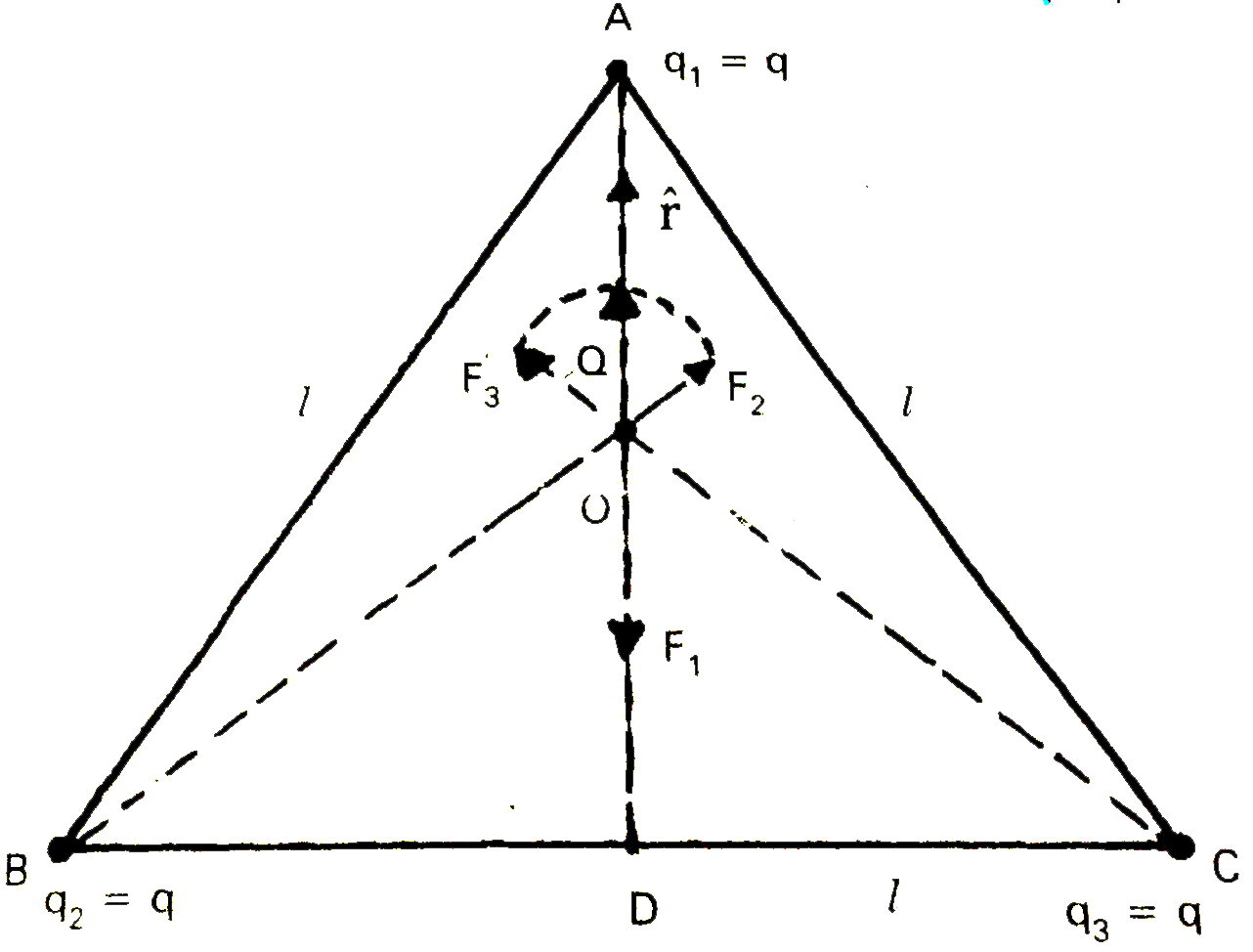consider three charges q1,q2,q3 each equal to q at the vertices of an equilateral triangle of side l what is the force on a charge Q placed at the centroid of the triangle
 Solution in Gujrati
Solution in Gujrati
In the given equilateral triangle ABC of sides of length l if we draw a perpendicualre AD to the side BC
AD=AC cos 30∘=√3/2 l and the distance AO of the centroid o from A is (23) AD=(1√3) l by symmatry AO=BO=CO
force F1 and Q due to charge q at A=34πε0Qql2 along AO
force F2 and Q due to charge q at B=34πε0Qql2 along AO
force F3 and Q due to charge q at C=34πε0Qql2 along AO
parallelogram law therefore the toal force on Q =34πε0Qq4πε0Qql2(→r−→r)
=0 where →r is the unit vector along OA
it is clear alos by symmetry that the three forces will sum to zero consider what would happen if the system was rotated through 60∘ about O
Topper's Solved these Questions
- ELECTRIC CHARGES AND FIELDS BOOK - NCERT GUJARATICHAPTER - ELECTRIC CHARGES AND FIELDS EXERCISE - EXERCISES
34 Videos
- DUAL NATURE OF RADIATION AND MATTERBOOK - NCERT GUJARATICHAPTER - DUAL NATURE OF RADIATION AND MATTEREXERCISE - EXERCISES
41 Videos
- ELECTROMAGNETIC INDUCTIONBOOK - NCERT GUJARATICHAPTER - ELECTROMAGNETIC INDUCTIONEXERCISE - ADDITIONAL EXERCISES
7 Videos
Similar Questions
What is the force between two small charged speres having charges of 2×10−7 c and 3×10−7 c placed 30 cm apart in air
View SolutionFind the
(a) maximum frequency, and
(b) minimum wavelength of X-rays produced by 30 kv electrons.
View SolutionSuppose the loop is stationary but the current feeding the electromagnet that produces the magnetic field is gradually reduced so that the field decreases from its initial value of 0.3 T at the rate of 0.02 T s−1. If the cut is joined and the loop has a resistance of 1.6 Ω, how much power is dissipated by the loop as heat ? What is the source of this power ?
View SolutionConsider the charges q,q and -q placed at the vertices of an equilateral triangle of each side l. What is the force on each charge ?
View SolutionConsider three charges q_(1),q_(2) and q_(3) each equal to q at the verticles of an equilateral triangle of side 'l' what is the force on any charge due to remianing charges.
View SolutionThree charges are placed at the vertices of an equilateral triangle of side 10 cm. Assume q_(1)=1 muC,q_(2)=-2 muC and q_(3)=4 muC . Work done in separating the charges to infinity is
View Solutionतीन आवेशों q1,q2,q3 पर विचार कीजिये जिनमे प्रत्येक q के बराबर है तथा l भुजा वाले समबाहु त्रिभुज के शीर्षो पर स्थिर है । त्रिभुज के केन्द्रक पर चित्र 1.9 में दर्शाए अनुसार स्थिर आवेश Q (जो q का सजातीय) पर कितन परिणाम बल लग रहा है ?

View SolutionConsider three charges q1,q2,q3 each equal to q at the vertices of an equilateral triangle of side l. What is the force on a charge Q (with the same sign as q) placed at the centroid of the triangle, as shown in Fig. ?

View SolutionConsider three charges q1,q2 and q3 each equal to q at the vertices of an equilateral triangle of side 'l' what is the force on any charge due to remaining charges.
View SolutionConsider three charges q_1,q_2,q_3 each equal to q at the vertices of an equilateral triangle of side l. what is the force on a charges Q ( with the same sign as q) placed at the centroid of the triangle,as shown in figure?
View Solutionconsider three charges q1,q2,q3 each equal to q at the vertices of an equilateral triangle of side l what is the force on a charge Q placed at the centroid of the triangle

View SolutionThree charges of equal magnitude q is placed at the vertices of an equilateral triangle of side l. The force on a charge Q placed at the centroid of the triangle is
View SolutionConsider three charges q1,q2,q3 each equal to q at the vertices of an equilateral triangle of side l. What is the force on a charge Q (with the same sign as q) placed at the centroid of the triangle, as shown in figure ?

View Solutionconsider three charges q_(1),q_(2),q_(3) each equal to q at the vertices of an equilateral triangle of side l what is the force on a charge Q placed at the centroid of the triangle
View SolutionConsider the charges q,q and -q placed at the vertices of an equilateral triangle of each side l. What is the force on each charge ?
View Solution
